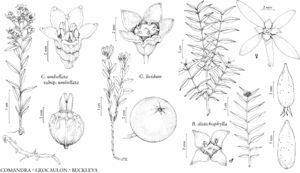Difference between revisions of "Comandraceae"
FNA>Volume Importer |
imported>Volume Importer |
||
| (3 intermediate revisions by 2 users not shown) | |||
| Line 48: | Line 48: | ||
|basionyms= | |basionyms= | ||
|family=Comandraceae | |family=Comandraceae | ||
| + | |illustrator=Yevonn Wilson-Ramsey | ||
| + | |illustration copyright=Flora of North America Association | ||
|distribution=North America;Mexico;Eurasia. | |distribution=North America;Mexico;Eurasia. | ||
|reference=None | |reference=None | ||
| Line 53: | Line 55: | ||
|publication year= | |publication year= | ||
|special status= | |special status= | ||
| − | |source xml=https:// | + | |source xml=https://bitbucket.org/aafc-mbb/fna-data-curation/src/2e0870ddd59836b60bcf96646a41e87ea5a5943a/coarse_grained_fna_xml/V12/V12_840.xml |
}}<!-- | }}<!-- | ||
-->[[Category:Treatment]] | -->[[Category:Treatment]] | ||
Latest revision as of 19:17, 5 November 2020
Herbs or subshrubs, perennial, root parasites, deciduous, synoecious or andromonoecious; glabrous. Stems horizontal rhizomes bearing erect fertile shoots. Leaves alternate, simple; stipules absent; petiole present or absent; blade margins entire; venation pinnate. Inflorescences unisexual [bisexual], axillary cymules or terminal thyrses. Flowers bisexual or unisexual; perianth and androecium epigynous; hypanthium completely adnate to ovary or adnate to ovary proximally, free distally; sepals 0; petals (4–)5(–7), usually connate basally, sometimes distinct, valvate, post-staminal hairs present; nectary present; stamens (4–)5(–7), opposite petals, distinct, free; anthers dehiscing by longitudinal slits; pistil 1, 1-carpellate, ovary inferior, 1-locular, placentation free-central, pendulous; ovules 2–4 per locule, anatropous; style 1; stigma 1. Fruits pseudodrupes (mesocarp hard, exocarp leathery or fleshy). Seeds 1 per fruit.
Distribution
North America, Mexico, Eurasia.
Discussion
Genera 2, species 2 (2 in the flora).
Comandraceae have not been recognized at the family rank in past classifications, although Comandra was placed in its own invalidly published tribe Comandreae by P. van Tieghem (1896). Comandra and Geocaulon have a suite of generalized morphological features that can be found in many other genera of Santalaceae in the broad sense. Despite this, Comandra has a number of distinctive embryological features (B. M. Johri and S. P. Bhatnagar 1960; M. Ram 1957). A molecular phylogenetic analysis recovered a strongly supported Comandra and Geocaulon clade, which was recognized as a family by D. L. Nickrent et al. (2010). That clade was placed in a polytomy with other Santalaceae in the broad sense in that study. Comandra and Geocaulon are clearly closely related as revealed by molecular studies; however, M. L. Fernald (1928e) made a good case for maintaining them as separate genera. They differ in a number of features involving the rhizome, plant sex, hypanthium, disc shape, style length, and fruit type.
Selected References
None.
Illustrations
Key
| 1 | Inflorescences terminal thyrses; flowers bisexual; hypanthia free distally, obconic; nectaries lining hypanthium; styles filiform; pseudodrupe exocarps leathery. | Comandra |
| 1 | Inflorescences axillary cymules; flowers bisexual and staminate (plants andromonoecious); hypanthia completely adnate to ovaries; nectaries nearly flat; styles short-conic; pseudodrupe exocarps fleshy. | Geocaulon |
